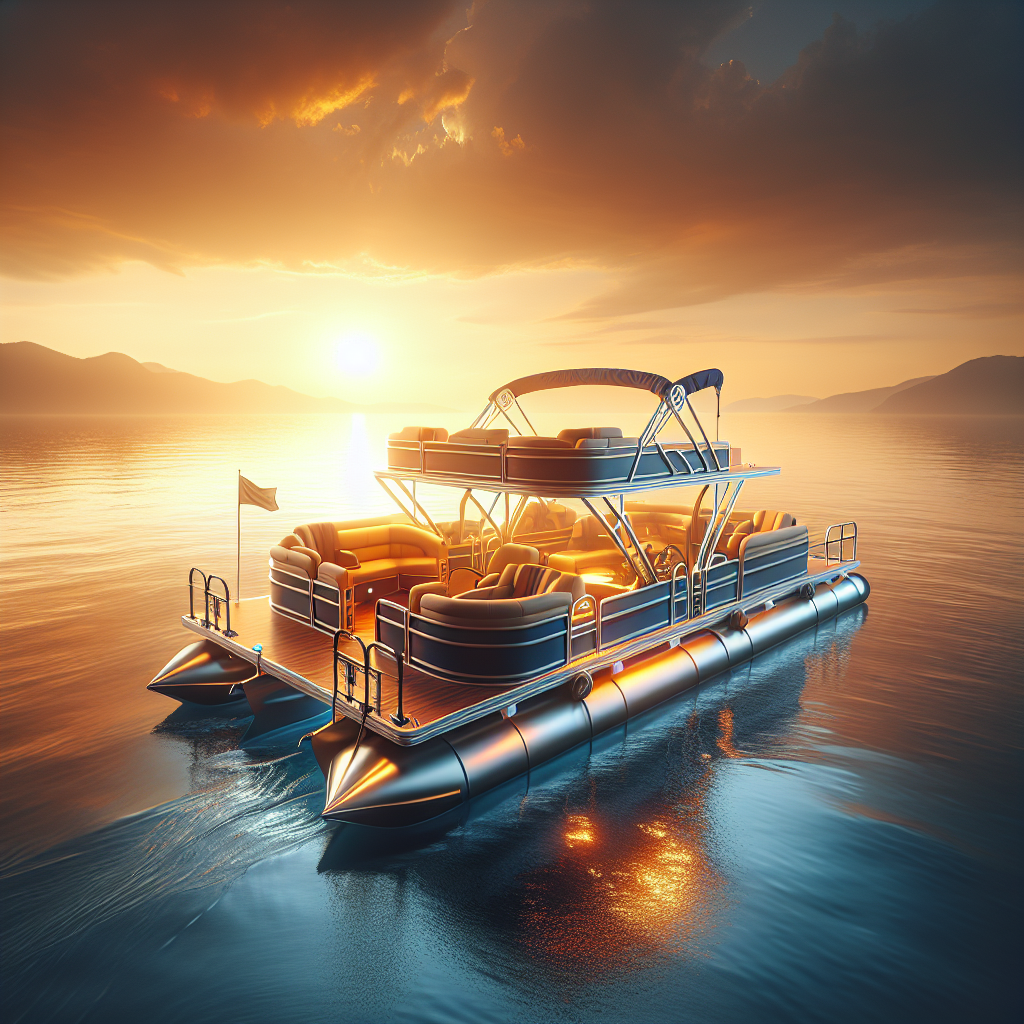Introduction to Pontoon Boat Sea Legs
Pontoon-boat-sea-legs are a must-have for every pontoon boat owner who values convenience and practicality on the water. Sea legs are retractable hydraulic stabilizers that provide instant stability and support for your watercraft when you are docked or anchored. They eliminate the need for cumbersome and unreliable anchors, ropes, and buoys, allowing you to enjoy boating without hassle.
In this article, we will explore everything you need to know about pontoon boat sea legs, from understanding how they work and their benefits to choosing the right model for your boat and installing and maintaining them.
Understanding Pontoon Boat Sea Legs
Pontoon boat sea legs are essentially hydraulic jacks that extend from the underside of your boat, providing a stable and solid platform when you are stationary. The sea legs are powered by a hydraulic lift system operated by a remote control, allowing you to deploy and retract them quickly and easily.
Benefits of Installing Sea Legs on Your Pontoon Boat
The benefits of pontoon boat sea legs are many. First and foremost, they provide excellent stability and support, ensuring your boat remains level and secure even in rough waters. They also eliminate the need for anchors, ropes, and chains, which can be cumbersome and time-consuming to use. Additionally, sea legs make it easier to embark and disembark from your boat, as you don’t have to worry about it rocking and swaying too much.
The Increasing Popularity of Sea Legs in the Boating Community
Sea legs have become increasingly popular in the boating community in recent years. Many boat owners have realized the convenience and practicality that sea legs provide, and have thus invested in them. Sea legs are easy to use, reliable and durable, and are a fantastic value addition to your pontoon boat. They are also compatible with most pontoon boats, adding to their popularity.
Key Features of Pontoon Boat Sea Legs
Hydraulic Lift Systems
One of the most significant advantages of pontoon boat sea legs is the hydraulic lift system they employ. Sea legs offer an alternative to traditional boat lifts, which can be bulky and frustrating to operate. The hydraulic system is easy to use, and through simple controls, you can lower or lift the sea legs in seconds. Hydraulic lifts provide ease of use and give you superior control over your boat.
Remote Control Operations
Another feature of pontoon boat sea legs is the ability to operate them remotely. The remote control feature gives you the advantage to lower and lift your sea legs from a reasonable distance. For example, you can start the sea leg system while still on the shore, or standing on the dock next to your pontoon boat. The remote control feature improves usability, particularly for boaters with physical limitations, making it easy to operate.
Stability and Support Provided
Pontoon boat sea legs offer excellent stability and support compared to using boat anchors. The sea legs provide support during waves and high winds, which can be risky when docked without leg support. The advanced engineering of these legs can support a considerable weight and enhance the overall balance of your boat. Stability and support are key reasons pontoon boat owners prefer installing sea legs.
Compatibility with Different Pontoon Boats
Pontoon boat sea legs are designed to be compatible with different pontoon boats. Many manufacturers produce standard sea legs to fit different boats, and some offer customized solutions tailored explicitly for your boat’s specific requirements. It’s important to ensure the compatibility of the sea legs with your boat before purchasing to avoid compatibility issues and propel your boating experience.
Selecting the Right Sea Legs for Your Pontoon Boat
Choosing the right sea legs for your pontoon boat is a critical decision that can significantly impact your boating experience. In this section, we will explore the key factors to consider while selecting sea legs for your pontoon boat.
A. Assessing Weight and Size Requirements
One crucial factor to consider while selecting sea legs is assessing weight and size requirements. Pontoon boats come in different sizes, shapes, and weights. It’s essential to ensure that you choose sea legs that can support the weight and size of your boat. Overloading sea legs can lead to instability, poor boat performance, and structural damage.
B. Considering Build Quality and Material
Build quality and materials used in making sea legs play a vital role in determining their durability, reliability, and efficiency. Sea legs made from robust and high-quality materials offer better stability and support. They also last longer, saving you from frequent repairs and maintenance costs.
C. Comparing Different Brands and Models
With many pontoon boat sea legs available in the market, it’s crucial to compare different brands and models to identify the most suitable one for your boat. Researching and comparing different sea legs’ prices, features, and reliability can save you money in the long run, ensure optimal performance, and enhance your boating experience.
D. Understanding the Installation Process
Another critical factor to consider while selecting sea legs is the installation process. While some sea legs are easy to install, others require professional installation, adding extra expenses. It’s vital to understand the installation process before selecting sea legs. Ensure that you can install the sea legs yourself or hire a professional, depending on your technical skills and budget.
Installation and Maintenance
When it comes to installing pontoon boat sea legs, it’s important to take a few factors into account to ensure optimal performance and safety.
A. Step-by-Step Guide to Installing Sea Legs
Before starting the installation process, make sure to read the manufacturer’s instructions thoroughly. It’s also recommended to gather all necessary tools and equipment beforehand.
The installation process typically involves the following steps:
- Position the sea legs on the pontoons and mark where the brackets need to be attached
- Attach the brackets to the pontoons, making sure they are securely in place
- Mount the hydraulic pump and motor assembly, ensuring proper alignment
- Attach the actuator with the hydraulic cylinder to the brackets and pump assembly
- Test the sea legs to ensure they are functioning properly
If you’re not comfortable installing the sea legs yourself, it’s recommended to have a professional do it for you.
B. Regular Maintenance Tips
To keep your pontoon boat sea legs functioning properly, it’s important to perform regular maintenance. Here are a few tips:
- Check the hydraulic fluid level and top off if necessary
- Inspect the brackets and bolts for any signs of wear or damage
- Lubricate moving parts to ensure smooth operation
- Clean the sea legs with a mild soap and water solution to remove any debris or salt buildup
C. Troubleshooting Common Issues
If you encounter issues with your pontoon boat sea legs, it’s important to address them promptly to avoid further damage or safety concerns. Here are a few common issues and their solutions:
| Issue | Solution |
|---|---|
| Slow or uneven operation | Check the hydraulic fluid level and ensure there are no leaks. If the issue persists, contact a professional. |
| Strange noises or vibrations | Check for loose bolts or parts, and inspect the hydraulic system for any signs of damage or wear. If necessary, contact a professional. |
| Sea legs not retracting fully | Check for debris or obstruction in the brackets or hydraulic cylinder. If necessary, contact a professional. |
D. Professional Services for Installation and Repair
If you’re not comfortable installing or repairing your pontoon boat sea legs yourself, it’s recommended to seek the services of a professional. They have the knowledge, expertise, and tools necessary to ensure your sea legs are installed and maintained properly.
When selecting a professional, be sure to research their reputation and experience in working with pontoon boat sea legs. It’s also recommended to ask for references and check their credentials and insurance coverage.
By following these installation and maintenance tips, your pontoon boat sea legs can provide years of reliable performance and improve your boating experience on a variety of water conditions.
| Topic | Key Points | ||||||||
|---|---|---|---|---|---|---|---|---|---|
| Installing Sea Legs |
| ||||||||
| Regular Maintenance Tips |
| ||||||||
| Troubleshooting Common Issues |
| ||||||||
| Professional Services |
|
Practical Usage and Safety Considerations
Now that you have installed sea legs on your pontoon boat, it is important to understand how to use them effectively and safely. Here are some practical usage and safety considerations to keep in mind:
A. Best Practices for Using Pontoon Boat Sea Legs
- Always activate sea legs before loading passengers or cargo onto the boat.
- Make sure the boat is properly aligned with the dock before lowering the legs.
- Use the remote control to adjust the height of the legs as needed.
- Lower the sea legs before starting the engine to avoid damage.
By following these best practices, you can ensure that your sea legs provide maximum stability and support while your pontoon boat is moored.
B. Navigating Different Water Conditions with Sea Legs
While sea legs are designed to provide stability on a variety of water conditions, it is important to understand their limitations. Here are some factors to consider when navigating different water conditions with sea legs:
| Water Condition | Considerations |
|---|---|
| Choppy Conditions | Sea legs may be less effective in high winds or rough waves. Adjust the legs accordingly and consider additional mooring lines for added stability. |
| Shallow Water | Make sure the sea legs are not in danger of hitting the bottom. Use the remote control to raise or lower the legs as needed. |
| Tidal Changes | Adjust the height of the legs to match the changing water level. Check the sea leg manual for specific instructions. |
C. Safety Tips for Operators and Passengers
Operating a pontoon boat with sea legs requires extra care and attention. Here are some safety tips for operators and passengers:
- Always wear a life jacket when boating.
- Never leave the boat unattended while the sea legs are deployed.
- Make sure all passengers understand how to use the sea legs properly.
- Do not exceed the weight or size requirements for your specific sea legs model.
D. The Impact of Sea Legs on Boat Performance and Value
Sea legs can be an investment in the long-term value of your pontoon boat, providing added support and protection. However, it is important to consider the impact of sea legs on boat performance. Here are some things to keep in mind:
- Sea legs may impact boat speed and fuel efficiency. Consider this when planning boating trips and fuel costs.
- Proper maintenance and care of sea legs can help maintain the overall value of your boat.
- Consult with a marine expert or sea legs manufacturer for specific recommendations and guidance.
FAQs
1. Can I install sea legs on any pontoon boat?
It depends on the specific model and weight requirements of the sea legs. Make sure to carefully assess the compatibility of the sea legs with your pontoon boat before installation.
2. How do I maintenance pontoon boat sea legs?
Regular maintenance includes cleaning, lubricating moving parts, checking hydraulic fluids, and inspecting for any signs of damage or wear. Refer to the sea leg manual for specific maintenance instructions.
3. What is the approximate cost of pontoon boat sea legs?
The cost of sea legs varies by model and manufacturer. Expect to pay anywhere from $5,000 to $20,000 for a set of sea legs, not including installation or maintenance costs.






